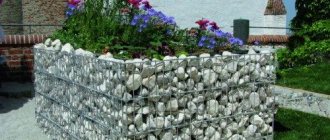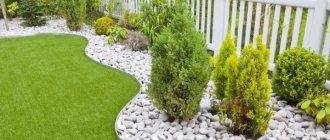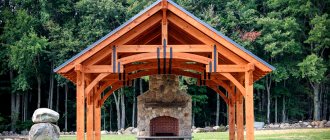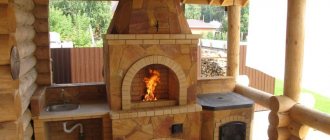Today we will meet with woody owners of “cold” beauty, endowed with silver, gray-green, bluish leaves.
Let me remind you that you have already become acquainted with herbaceous species in the articles Silver-leaved herbaceous plants - decorating a summer house from spring to autumn and Silver-leaved herbaceous plants: flower beds for gourmets. European olive - the silvery beauty of the South Coast, photo by the author Such plants are exquisite and look luxurious, as if skillfully made of precious metal. They have an “aristocratism” by nature, which can simultaneously be attributed to both their advantage and disadvantage. And here's the reason.
The silvery leaves of Perovsky and dark foldifolia become invisible when it blooms, photo by the author. Each time you will have to carefully think through, weigh, and determine the planting location for a silvery tree or shrub, as they will look gorgeous against the background of a gray or dark brown stone wall (fence, arch , gazebos), but will not fit into the plant composition near the bright brickwork.
Perovskia dark-fold-leaved near a stone arbor, photo by the author. Silver goofy near a stone arch. Photo from landas.ru
They will pick up the idea of a mixborder in cool colors, as accents or as extras in contrasting compositions with dark purple, violet forms, plants with flowers of the same color or blue, light blue.
Contrasting composition with silver pear. Photo from the site s-media-cache-ak0.pinimg.com
Despite their exquisite outfit, they will often not be accepted into the bright round dance of plants with yellow and red flowers. The exception will be silvery species and forms, endowed with inflorescences of warm tones by nature.
Santolina cypress in bloom will be harmonious in a flower garden with warm colors, photo by the author. In it, but later, the Sunshine Blue karyopteris realizes itself. Photo of the site c4.provenwinners.com
The fashion for silvery wood will never go away either in the south or in the north, since they have the power to soften contrasting combinations and harmonize in nuanced compositions.
Silver lavandin, photo by the author
Some of them are familiar to you from previously published materials on the pages of the site and, perhaps, some are even already growing in your dacha.
Dubrovnik bush, photo by the author
Other species and forms are only included in the lists of planned acquisitions and plantings.
Decorative form of sea buckthorn. Photo from havlis.cz. Eleven angustifolia. Photo from the site img-fotki.yandex.ru
The third ones are already in front of you. Meet the most beautiful “cold” beauties and handsome men for the dachas of central Russia and the south.
Ads by
Botanical description
This plant is a low deciduous shrub 1–5 m high. Numerous branched shoots form a wide spreading crown of a spherical or pyramidal shape. Tree forms are very rare. The bark is grayish-brown, the branches are prickly, covered with tiny silvery scales.
The root system of the sucker is powerful and grows far to the sides. Sometimes the roots extend several meters from the trunks.
A characteristic feature of the shrub is its beautiful decorative leaves. They are elongated, lanceolate in shape with a wedge-shaped base and pointed tips. Arranged alternately on short cuttings. The length of the plate is 8–10 cm, width is 2–3 cm. On the front side, the leaves are leathery, bluish-green in color, on the back side they are rough, covered with tiny silvery scales. Thanks to the beautiful metallic sheen, the crown of the plant has an unusual appearance and stands out clearly against the background of other trees and shrubs.
At the end of May, the bush throws out fragrant inflorescences that look like small bells. Their petals also have a silvery tint on the outside, and bright yellow on the inside. The flowering period lasts 20–25 days. At this time, the fragrant aroma spreads throughout the area and attracts pollinating insects.
Lokhovnik is a monoecious plant and a good honey plant. The fruits ripen in August or early September. They are round drupes about 1 cm in size with silver-gray skin that becomes lingonberry in color when ripe. They hang in small tassels on thin stalks. Externally, the green berries of the oleaster are similar to olives, which is why the plant is also called wild olive. Inside the fruit there is a thin layer of pulp, sweetish in taste, and a large oblong dark bone. The age of fruiting begins in plants from 6–7 years of life; in cultivated specimens it may be earlier—from 4–5 years. One adult plant can produce a harvest of up to 30 kg of berries.
Garden design. Shrubs, trees with silver leaves
The leaves of the tree are lanceolate, gray and very soft.
Trees and shrubs with silver leaves add special splendor to the garden design, creating a decorative contrast even with plants that have a regular color. Many owners of private houses and summer cottages use plants of noble silver tones in the design of their gardens. This is explained by the fact that gray foliage looks decorative throughout the season and serves as an excellent tone for its brighter “neighbors.”
Silvery foliage goes well with white, blue, indigo and purple flowers. Silver tones are associated with the gentle south. Indeed, whitish foliage can be found more often in the southern regions.
Trees and shrubs with silver leaves
A frequent “inhabitant” of gardens is dwarf or tall willow. Many gardeners rely on white silver willow, which grows up to 25 meters in height. Its width is 15 m. Experienced gardeners maintain the desired height of such a tree by pruning it annually. Periodically trimmed to resemble a stump, willow can be grown in bush form. Shrub willows are suitable for summer cottages. For example, you can buy a woolly or creeping "Argenteu".
The first plant is a round, meter-long bush.
Perennials with silver leaves
Wormwoods feel comfortable in a dry, sunny area. The decorative effect of their openwork foliage remains throughout the entire season. The most spectacular low-growing wormwoods include Caucasian and cold. If you are planning to decorate a flower garden, pay attention to the highly decorative Schmidt wormwood, which differs favorably from its “relatives” with its rounded, dense openwork bushes and pinnately dissected leaves. This way the plant goes under the snow, and in the spring new shoots grow. Smoky cushion-shaped bushes will decorate any flower garden and dilute coniferous plantings. Varietal plants, such as “Nana,” are often found in gardens.
The spreading 30-centimeter bushes of Steller's wormwood look no less interesting. To keep the bush always compact, it is pruned every year. Such wormwood is rejuvenated by division (an alternative is hilling). Silver-gray bushes go well with sedum, gray fescue, clary sage and creeping gypsophila.
The list of perennials with silvery foliage is not limited to wormwood alone. In June, pearl anaphalis blooms - an unpretentious, erect, weakly branched bush, the height of which reaches 35 cm. The stems of the plant are covered with gray hairs, and the lanceolate leaves are covered with a white coating. Interestingly, the back side of the leaves seems to be covered with brown velvet. White basket flowers are collected in corymbose inflorescences and delight with their flowering until the end of summer. The only thing that needs to be taken into account before “planting” a perennial in a prominent place is its aggressive growth.
Many gardeners have long been familiar with the woolly chickweed, or, as it is popularly called, “sheep’s ears.” The plant was probably so nicknamed because of the white edge on the elongated leaves. This is a 35-55 cm semi-bush. Several distinctive features of woolly chickweed: thick gray-green shoots and leaves, lilac flowers that form long inflorescences that are very similar to ears. For the shape of its inflorescences, the chist once received its Latin name “stachys”, which translated means “spike”. Due to the unusual texture and color of chistets leaves, they are often included in compositions of alpine slides.
Chistets woolly - Latin name "stachys"
You can choose the compact variety “Silky Fleece” or the non-flowering variety “Cotton Bell”.
Of the “gray-haired” ground covers in the garden, there will certainly be a place for geraniums - felt and Bieberstein. Tomentosa is a creeping plant with raised shoots. The leaves of the tree are lanceolate, gray and very soft. The small white flowers that cover it with a dense cap give the plant a special charm. The perennial blooms in early May, and although the flowering lasts only a month, after the shoot it remains no less decorative.
Bieberstein's Yaskolka is as mysterious as its homeland, Crimea. The herbaceous perennial covers the ground with a dense silvery cushion, on the surface of which, at the end of spring, white flowers bloom, collected in few-flowered umbrellas. The lilies are completely unpretentious and do well in partial shade, but to make them look attractive, they need pruning after flowering and at the end of summer.
Silver paints in a shady flower garden
Growing “living metal” has its own rules. And usually the silver color of the foliage lasts only in bright sun. In the shade, and also after the onset of cold weather, the color becomes less intense, and the plants themselves become thinner. Therefore, for shady areas you should select plants that can easily tolerate the lack of sunlight.
To decorate a shady flower garden, speckled claret is suitable. The plant has gained popularity among gardeners due to its jagged dark greenish leaves with a silver spot along the central vein and fragrant purple whorl inflorescences, delighting with their beauty throughout the summer. It is worth paying attention to varieties with attractively colored foliage and flowers, like the main species. These are, first of all: “Aureum”, which attracts with its yellow leaves with a silver pattern, “Chekere” with purple leaves decorated with a silver stripe, and “White Nancy” whose silver leaves are framed by a dark greenish stripe. If you plant several subspecies of speckled damselfish at once, then you can expect self-seeding with the most unexpected color options for inflorescences and leaves.
It is impossible not to mention the kings of shady areas - ferns. Here are several varietal carriers of “silver”: “Metallica Crispa” and “Ursulas Red”. The Pictum variety is also popular. This 70cm tall fern grows quickly.
Incredibly attractive plants with velvety gray foliage are indispensable softening tools for landscape designers. Silver foliage does not create contrasts. It acts as a soft background and smoothes out the excessive diversity of flower beds. Without these amazing crops, the bold colors of flowering plants would seem disordered, and the purple and white inflorescences would never reveal their magical beauty.
Did you like the article? Subscribe to the channel to stay up to date with the most interesting materials
Source
Growing conditions and varieties
Lokhovnik loves well-lit areas, is quite unpretentious, undemanding in terms of nutritional value and soil composition, tolerates frosts down to -40°C and can easily be grown in a temperate or continental climate, on rocky soils and sandstones. The lifespan of the bush reaches 25–30 years.
The varieties of silver eelgrass are:
- Eleven angustifolia: a tall, dense frost-resistant shrub with elongated leaves 1.5–2 cm wide, producing edible fruits;
- Eleven multiflora (gum): a low-growing plant about 1.5 m high with bright green foliage and red fruits, found in China and Japan.
Lokhovnik wood has high technical characteristics. The width of the logs reaches 30 cm. The sapwood is pale yellow, the heartwood is slightly darker. The array is wide-layered and does not crack or deform when dried. Density is 670–710 kg/cub.m.
Red elderberry Sutherland Gold
Red elderberry Sutherland Gold
A fast-growing shrub that can reach a diameter of 3 m without regular pruning. It loves partial shade and is undemanding to the soil. In early spring, the elderberry bush of this variety is covered with yellowish flowers, and in summer - with clusters of bright red berries. Despite the fact that the inflorescences of this plant have almost no smell, pollinating insects love it.
Application of the plant
Silver oleaster lumber lends itself well to processing and is used in carpentry. Various small parts for furniture and musical instruments are turned from it. Gum extracted from waste is used in printing houses and the textile industry.
The berries, flowers, and leaves of the euphemum have valuable medicinal properties and are used in traditional medicine. The pulp of the fruit is edible, tastes like cherries, contains carbohydrates, vegetable protein, vitamins, organic acids, phytocyanins, and antioxidants. Catechins, tannins, steroids, alkaloids and many other active substances were found in the leaves and flowers. You can make compotes, preserves and jams from the berries.
Infusions and decoctions of herbs and fruits are used as an anti-inflammatory, anthelmintic, bactericidal, choleretic and analgesic. They treat skin lesions, gastrointestinal ailments, and cardiovascular disorders.
Silver elk honey is considered one of the most useful. It is recommended for patients with pancreatitis and gastric diseases.
How to plant?
When considering this crop for rooting in your garden, it is worth knowing some of the nuances regarding planting cineraria. In general, all varieties of ragwort adapt well and develop in any soil. However, the plant will feel best in soils enriched with useful microelements with good aeration, without stagnant moisture, which can lead to rotting of the root system.
Therefore, before planting, it is recommended to fertilize the selected area with mineral compounds intended for garden flowers. If you plan to plant several shrubs, then the holes for planting need to be prepared in increments of 20-25 centimeters, this also applies to the spaces between the rows. If you want to get a thick, continuous carpet of cineraria in your flowerbed, then the distance between the seedlings can be reduced.
The planting algorithm includes several steps.
- The required number of holes are dug in the area, with a depth greater than the root system of the plants selected for planting.
- Rooting involves placing the cineraria in the middle of the hole together with a clod of earth. At the same time, you should try to maintain its integrity.
- Next, the soil is compacted and the crops are irrigated.
- If planting is carried out during a period when night frosts are possible, care should be taken to provide shelter for the flowers at night. For these purposes, you can use any non-woven material, garden film.
The suitable temperature for the development of cineraria in open ground is 20°C. However, healthy plants that have already gone through an adaptation period after planting are able to withstand minor daily changes in thermometer values. The critical temperature for the crop will be 4°C and below. Under such conditions, the above-ground part of the plant will begin to die.
Use in landscape design
The shrub itself is excellent for landscaping streets and creating ensembles in landscape design. Strong, spreading roots make it possible to use silver oleaster to strengthen the slopes of ravines and cliffs. The plant is capable of independently releasing nitrogen, which is necessary for further development. The undemanding nature of soil nutrition and resistance to unfavorable conditions of the urban atmosphere further increase the value of the plant. He is not afraid of polluted and dusty air.
In winter, after dropping its foliage, the eelgrass does not lose its decorative appearance. Beautifully intertwined scaly shoots give the crown a delicate openwork appearance. In landscape design, silver shrubs look great next to conifers: spruce, thuja, juniper, shading their green or bluish needles. Decorative compositions with scumpia, red-leaved maples, and other shrubs and trees with colored and contrasting crowns look beautiful.
An attempt to create hedges from this plant may be unsuccessful: the sucker produces a lot of basal shoots, which over time violate the boundaries defined for it. If the silver shrub is nevertheless planted as a fence for the site, it will be necessary to maintain a distance of 70–100 cm between specimens in order to give the necessary freedom to the root system. Subsequently, new shoots may appear within a radius of 5 m from the mother plant.
The biological cycle of silver oleagin fits well with the changing seasons of the temperate climate zone, which means the plant fits well into it. The periods of flowering and ripening of fruits occur in the warm months and allow you to get a harvest.
Silver poplar for landscaping parks
White or silver poplar is a frost-resistant crop, characterized by fast growth, unpretentiousness and the ability to release huge amounts of oxygen, which is important for landscaping city streets and squares. Belongs to the willow family, growing everywhere. There is probably no place in our country now that is not decorated with monumental poplar landscapes, groves and alleys framed by representatives of this culture.
Planting and care
You can plant shrubs in April or autumn. For it, it is optimal to choose well-lit or slightly shaded areas. Possible moisture stagnation should be taken into account - low-lying wetlands with heavy soils are not suitable for the plant. Dolomite mixture or lime will need to be added to acidified soil. Too heavy soils are diluted with sand. The soil should be loose and moisture-permeable.
Before planting, dig up the area and remove any existing debris. For seedlings, holes measuring 50x50x50 cm are dug. A drainage layer of stones or crushed bricks is laid on the bottom. You can add leaf humus on top. The roots of the seedlings are placed in holes, sprinkled with soil so that the necks are deepened by 6–8 cm. The trees are immediately watered. Tree trunk circles are covered with mulch made from sawdust, grass, pine needles, and compost. For the winter, it is recommended to additionally cover young plantings with spruce branches, agrofibre or straw, since severe frost or icy winds can damage them. Plants older than 4–5 years usually become frost-resistant.
Caring for a sucker is not difficult. During the warm season, it requires regular moisture. If there is insufficient rainfall, each bush is watered twice a week with 10 liters of water, since the superficial root system is not able to draw moisture from the deep layers.
The sucker does not require additional feeding, but if the bushes grow very poorly, you can periodically add superphosphate or humus to the soil.
The crown of the silver oleaster looks beautiful in its natural form, without pruning, but if desired, it can be given a certain geometric shape, especially when creating hedges. Trim the shoots with ordinary garden pruning shears. Drying branches also need to be removed periodically.
Perennials for sunny places
In dry sunny areas, wormwood will be out of competition. Moreover, both in the literal and figurative sense: they not only delight with their intense silver color, but also grow quickly, often overwhelming their neighbors.
Tall wormwood (aka Absinthe, 120 cm) is suitable only for large flower beds and massifs. It is aggressive, and in addition, has a depressing effect on other plants. P. Pursha and Ludovika are a little lower, but no less actively growing. These types of wormwood are durable and unpretentious. They do not need special care, but they lose their slimness and brightness of color if there is an excess of nitrogen in the soil.
The carved leaves of Schmidt's wormwood seem rather ashen, but are unusually graceful. Cushion-shaped bushes with delicate smoky foliage will decorate any flower garden or group with coniferous and deciduous shrubs. Periodic pruning of its shoots is welcome. Moreover, in gardens, it is often not species plants that are planted, but low-growing varieties - 'Nana' or 'Silver Mound'. Steller's low-growing wormwood is also beautiful.
It has woody shoots at the base and bright leaves with amazing patterns. This species gets wet easily, so the best place for it is in a well-drained area of a rocky garden. Needs pruning of shoots and regular rejuvenation of clumps.
But the matter, of course, is not limited to wormwood alone. Already in June, pearl anaphalis, an unpretentious perennial 50 cm high, will delight you with its dense clump. It is very aggressive, but just as elegant: its leaves and stems attract attention with their bright silver color
Its more compact and “well-mannered” relative is Anaphalis three-veined.
Many gardeners are familiar with the woolly chickweed (“sheep’s ear”), whose soft leaves are covered with thick grayish-silver fluff.
For those who don’t like its “lanky”, not very attractive peduncles,
We can recommend the compact variety 'Silky Fleece' with flower stems only 10 cm high
or 'Cotton Ball' - no flowers at all.
True, in the spring the clumps of chistema need to be put in order - to trim the shoots, to remove the leaves damaged during wintering.
Of the silvery groundcover perennials, the most indispensable in the garden are the tomentose and Biberstein.
They are suitable for creating borders, “carpets”, and are used as hanging perennials. They are completely unpretentious, grow well in partial shade, and even bloom elegantly in June. But cutting is required - after flowering and again at the end of summer.
Reproduction
The methods used to propagate suckerweed are cuttings, rooting of layering and germination from seeds. Oddly enough, it is vegetative methods that give the worst results: no more than ⅓ of the bush shoots take root and grow.
Cuttings are prepared before winter. They should be 15 cm long and have several leaves. They are pre-treated with phytohormones, and the sections are sprinkled with charcoal. For rooting, the shoots are placed in boxes with a mixture of peat and sand, left at a temperature of 16–18°C, and watered periodically. The branches that have taken root over the winter are transplanted into the ground.
When propagating by layering, circular cuts are made on the side shoots and pressed to the ground, sprinkled with soil. Layers are separated from an adult plant after the roots appear. Otherwise, after a few months the cut shoot is removed.
Plantings of basal children of the eelgrass, which are carefully separated from the mother specimen and transferred to a new place, take root more successfully.
Shrub seeds can be sown in late autumn. This way they will not lose their germination capacity and will undergo winter stratification. Place them in loose prepared soil to a depth of 7–10 cm, sprinkle with sawdust or leaves. After the snow melts, water generously. You can plant plant seeds in the spring, but to ensure germination you need to keep them at a temperature of +8–10°C for several weeks . In the first season, young shoots reach a height of 30–40 cm; in subsequent years, the growth of the bush slows down and is about 15 cm per year.
Cineraria maritima
The openwork leaves of this incredibly persistent summer plant will decorate any flower garden. The vitality and unpretentiousness of the plant allow it to be used even in urban flower beds. The yellow inflorescences of seaside cineraria look rather inconspicuous, so most often they are removed so that they do not spoil the decorative effect of the flowerbed. This summer plant is not very picky about soils, but prefers slightly acidic and crumbly light soils. In this case, in no case should you forget about lighting, because... It is thanks to bright sunlight that the leaves of the plant receive their unique silvery tint.
Spiraea japonica Golden Princess
The winter-hardy bush has a height of up to 50-60 cm. Spiraea is considered hardy - it easily tolerates pruning and is resistant to diseases and pests. From red-orange, the leaves turn yellow and then acquire a copper tint. Pink flowers appear on the bush in June and remain until the end of July.
It is used in the design of low borders and mixborders. Looks great in group plantings with small plants, for example, lavender.
Recent Entries
Chainsaw or electric saw - what to choose for the garden? 4 mistakes when growing tomatoes in pots that almost all housewives make Secrets of growing seedlings from the Japanese, who are very sensitive to the soil
Sea buckthorn
Sea buckthorn is a relatively short tree or multi-stemmed shrub that can easily tolerate both drought and frost. Unlike many other plants with silver leaves, it tolerates waterlogging without damage. Moreover, in nature, sea buckthorn prefers to grow in river valleys and slightly swampy areas.
Thanks to special bacteria living in the root system of the plant, sea buckthorn almost never needs nitrogen fertilizing. However, she may experience potassium deficiency.
Sea buckthorn in open ground - all about planting, care and propagation
Sour, prickly, rapidly growing - is this what you imagine sea buckthorn to be? Your information is quite outdated, now she is completely different!
How to care?
In order for the crop to demonstrate maximum attractiveness and to develop properly, a number of mandatory agrotechnical measures will need to be completed.
Cineraria is resistant to drought, so in the middle zone it usually has enough natural precipitation for nutrition. However, prolonged absence of watering should still be avoided in any case. You can determine that the plant in the flowerbed does not have enough moisture by the appearance of the above-ground part - the leaves of the groundsel become limp, and flowering stops or does not occur at all.
It is best to carry out root watering, avoiding moisture getting on the green mass. For irrigation, it is recommended to take only warm water, previously settled. The liquid should be injected between the rows, then loosened and weeds removed.
Top dressing
For good flowering and growth, it is best to feed cineraria bushes additionally. Some gardeners use mineral complexes twice a month. However, for the plant to fully develop, one injection of nitrogen-containing compounds in the active growth phase will be sufficient until the buds are laid in the spring.
Trimming
To grow a beautiful flowering plant in the garden, in the process of caring for cineraria, you need to promptly prune the wilted buds. Such simple manipulations will stimulate the plant to form new ovaries.
Wintering
In regions with a mild climate, ragwort bushes can be left in the flowerbed over the winter to preserve the crop in the garden for next year. To prevent unwanted freezing, gardeners usually resort to covering the plant with a layer of mulch, using garden foliage for this. In the spring, the shelter will need to be removed and sanitary pruning of fragments that were damaged during the winter period will be carried out.
In harsh climates, with significant drops in temperature in winter, cineraria is usually dug out of flower beds; for storage at home, the bushes are rooted in pots. It is recommended to keep plants at room temperature in winter, with occasional watering. In spring, the ragwort can be transplanted back into open ground.
Pear pear
The silvery beauty comes from our region - Crimea and the Eastern part of Asia Minor. We meet her on almost every hike in the Crimean Mountains.
The pear tree is blooming on Mangup, photo by the author. Pear tree in the composition. Photo from eutopiagardens.org
Pear tree (Pyrus elaeagrifolia) is a spectacular (often with thorns) tree up to 15 m high with narrow grayish (white-tomentose below) leaves. White flowers with a diameter of 2.5 cm bloom in April-May. Yellow-green fruits up to 3 cm in diameter ripen in October-November. It grows slowly.
Pear leaves, photo by the author. Fruit picking, photo by the author
It is an excellent tapeworm and member of dense thorny (both molded and free-growing) silver hedges. Winter-hardy: can withstand up to -30 °C; Grows better on open rocky and dry soils.
Propagated by stratified seeds for 3 months.
Buddleya Davida Silver Anniversary
This shrub has long shoots and fragrant flowers. There are several varieties of it with flowers that come in cream, pink and blue. Silver Anniversaries are characterized by white. The flowers have a rich aroma that attracts bees.
Buddleia grows quickly, so timely pruning is required to maintain its decorative appearance. This procedure will help to form a beautiful crown.











